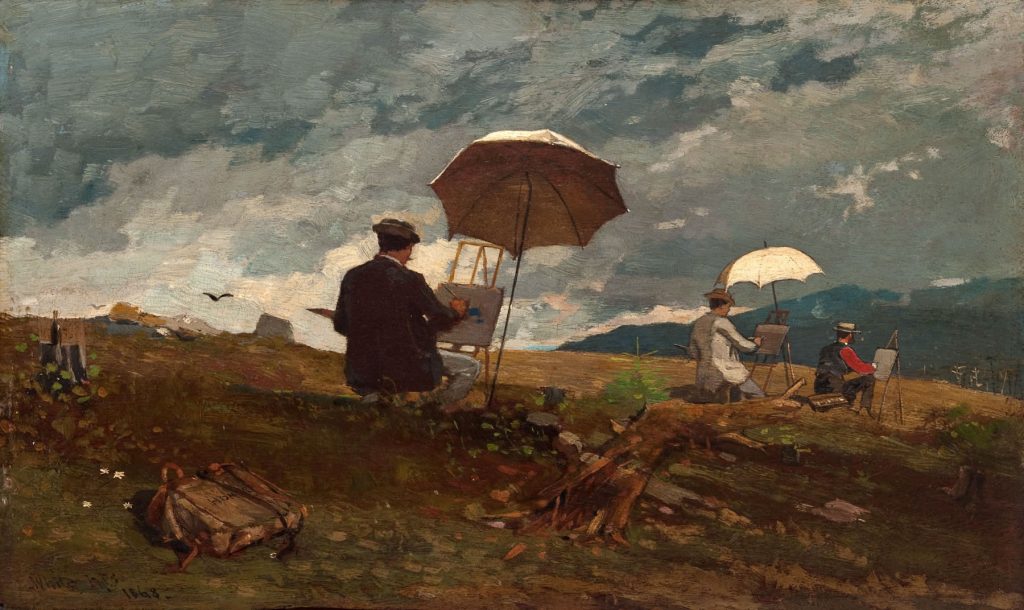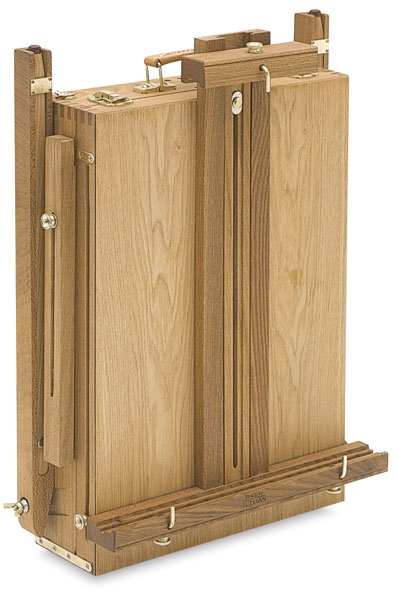Equipment
Whether you’re doing on-site pencil sketching, painting small colour panels, or working on larger canvases, you need to have the required equipment setup at your painting location as easily and as quickly as possible. Working in the unpredictable natural environment means having the right tools to help face the many challenges it can present.
The Mobile Studio

“Artists Sketching in the White Mountains” – Winslow Homer
To get the most out of your outdoor painting experience, it’s important to be as mobile and prepared as possible. Compact and light equipment becomes a critical factor for success, and allows you to adventure well away from the comforts of a permanent indoor studio. Luckily, there are a growing number of products available for this, and many artists even make their own tools to accommodate the demands of creating plein air artwork.
Portable Easels
The French Box Easel
The impressionists of late 19th century France were some of the first artists to really explore the outdoors with their painting gear. The French box easel was developed to help them do this. It basically has everything you need for on-location painting. It’s a large box supported by attached tripod legs. The box allows for paint and brush storage, and can accommodate small to quite large painting surfaces. It is on the bulky side however, and would have to be carried in hand on route to a site. They can also be a bit expensive and heavy, when compared to some of the other options.

The Half French Box Easel
The biggest issue with the French easel is it has to be carried in one hand as it’s too large to fit in a standard backpack. So, a lighter and smaller version has been developed, the half-box easel. Although it’s more restrictive in work surface area and storage, it is approximately half the size of the full easel and as such, is much more compact and light making it easier to fit into a backpack. It’s also a cheaper option, so this makes it more attractive to the beginner.
Pochade Boxes
The next phase of portable studio development has happened more recently with the growing plein air movement around the globe. Lighter and smaller boxes have appeared based on renewed demand, and are grouped under the name of “pochade” box. There are several styles that fit in this category:
These types of combined palette and easel are much smaller and lighter than the all-in-one French easels, but do require additional equipment such as a tripod for it to operate. These tripods tend to be standard photographic tripods with a detachable head that can be mounted directly onto the pochade box. Also, recent carbon fibre versions of tripods mean the weight factor is decreased once more, but unfortunately, the cost for these ultra-lightweight tripods can be pricey. The box itself offers a palette, often a storage area for paints, sometimes room for wet panels, and of course, an easel. However, because of the size limitations, these boxes tend to support only small painting surfaces, but this is ideal if you’re just creating field sketches for reference in your home studio.
I can’t really recommend any particular one of these having never used one myself, but they each have pros and cons depending on what you’re looking for. So explore the features of each and figure out which one you think would be right for your specific needs.
Other Options
There are several recent variations on the pochade style of field box, and a few new designs. These often expand the canvas size limitations of a pochade box, and reduce yet more weight.
The Coulter Art Box
One of my favourite configurations is showcased here by James Coulter. His art box has really paired down the essential equipment to a minimum, but still allows for large on-site painting if that’s your goal. I’ve made my own version of this using basic pre-cut lumber and three plywood painting panels. You need to be a little handy with basic woodworking, but I wanted to try out this type of system before investing. I was also able to make a couple of minor alterations for greater canvas and palette stability.

The Anderson or A-Frame Easel
Another type of easel for larger work is the Anderson/A-Frame Easel. This is much less compact, bit still quite light if you can shoulder-carry it, or strap it to the outside of your backpack. The big advantage is it will take very large canvases and remain quite stable. You may have to weigh it down in windy weather like most of these easels, but if you’re interested in working with 20 x 20 canvases or larger, then this is one worth looking at.
Other Equipment
Wet Panel Carrier
Not an issue for anyone other than oil painters really, but a wet-panel box is an important piece of equipment if you wish to preserve your hard work. There are several options, but most are made from light-weight plastic, and can be put in your pack or carried by their handle. Many of the larger pochade boxes come with built-in slots for small wet panels after you’re done.
A Pack
If you’re planning on going any distance from your vehicle, you’re going to need something to put equipment and supplies in. A good backpack is often the best option as they come in a range of sizes, are padded for comfort, and have plenty of room for your main equipment, paint, brushes, rags, and all the other small supplies needed for a mobile studio. There are packs made specifically for painters, but I’d look at standard ones first and see if you can’t find one to fit your specific needs. You might also look at laptop packs since these are squarer in overall shape and can accommodate pochade boxes with minimal wasted space (they are a bit more expensive due to additional padding and so on).
Sun and Weather Protection
You might also consider buying a light-weight umbrella. There are plein air umbrellas available online (Best Brella, etc.) that are designed to attach to your tripod, and will create adjustable shade for both your canvas and palette where there is none to be found on site.
A Seat
A small collapsible seat might also come it handy. These are usually quite light and compact, and can make longer painting sessions more comfortable, but they will add weight you can do without if there are places to sit on site.
Please check out the Supplies section of this site for everything else you’ll need to consider bringing.
